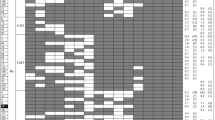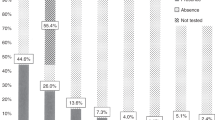Abstract
Kawasaki disease (KD) is a pediatric acute multisystemic vasculitis complicated by development of coronary artery lesions. The breakthrough theory on KD etiopathogenesis points to pathogens/environmental factors triggered by northeastern wind coming from China. Natural Killer cells and T lymphocytes express the inhibitory/activating Killer Immunoglobulin-like Receptors (KIR) to elicit an immune response against pathogens by binding to human leukocyte antigens (HLA) class I epitopes. We first report on the role of KIR/HLA genetic epistasis in a sample of 100 Italian KD children. We genotyped KIR, HLA-A, HLA-B and HLA-C polymorphisms, and compared KD data with those from 270 Italian healthy donors. The HLA-A*11 ligand for KIR2DS2/2DS4/3DL2 was a KD susceptibility marker by itself (odds ratio (OR)=3.85, confidence interval (CI)=1.55–9.53, P=0.004). Although no epistasis between HLA-A*11 and KIR2DS2/S4 emerged, HLA-A*11 also engages KIR3DL2, a framework gene encoding for a pathogen sensor of CpG-oligodeoxynucleotides (CpG-ODN), and KD blood mononuclear cells are actually prone to pathogen CpG-ODN activation in the acute phase. Moreover, carriers of KIR2DS2/HLA-C1 and KIR2DL2/HLA-C1 were more frequent among KD, in keeping with data demonstrating the involvement of these HLA/KIR couples in autoimmune endothelial damage. The highest KD risk factor was observed among carriers of KIR2DL2 and two or more HLA ligands (OR=10.24, CI=1.87–56.28; P=0.007).
This is a preview of subscription content, access via your institution
Access options
Subscribe to this journal
Receive 6 digital issues and online access to articles
$119.00 per year
only $19.83 per issue
Buy this article
- Purchase on Springer Link
- Instant access to full article PDF
Prices may be subject to local taxes which are calculated during checkout





Similar content being viewed by others
References
Uehara R, Belay ED . Epidemiology of Kawasaki disease in Asia, Europe and the United States. J Epidemiol 2012; 22: 79–85.
Tamburlini G, Strinati R, Cadorini S, Calligaris A, Coprivez A, Cozzi M et al. A two-year survey of mucocutaneous lymph node syndrome in northeastern Italy. Epidemiological and clinical findings. Helv Paediatr Acta 1984; 39: 319–329.
Newburger JW, Takahashi M, Gerber MA, Gewitz MH, Tani LY, Burns JC et al. Diagnosis, treatment, and long-term management of Kawasaki disease: a statement for health professionals from the Committee on Rheumatic Fever, Endocarditis, and Kawasaki Disease, Council on Cardiovascular Disease in the Young, American Heart Association. Pediatrics 2004; 114: 1708–1733.
Kato H, Sugimura T, Akagi T, Sato N, Hashino K, Maeno Y et al. Long-term consequences of Kawasaki disease. A10- to 21-year follow-up study of 594 patients. Circulation 1996; 94: 1379–1385.
Burns JC, Glodè MP . Kawasaki Syndrome. Lancet 2004; 364: 533–544.
Muta H, Ishii M, Yashiro M, Uehara R, Nakamura Y . Late intravenous immunoglobulin treatment in patients treated for Kawasaki disease. Pediatrics 2012; 129: e291–e297.
Alexoudi I, Kanakis M, Kapsimali V, Vaiopoulos G . Kawasaki disease: current aspects on aetiopathogenesis and therapeutic management. Autoimmun Rev 2011; 10: 544–547.
Rowley AH . Kawasaki disease: novel insights into etiology and genetic susceptibility. Annu Rev Med 2011; 62: 69–77.
Oh JH, Han JW, Lee SJ, Lee KY, Suh BK, Koh DK et al. Polymorphisms of human leukocyte antigen genes in Korean children with Kawasaki disease. Pediatr Cardiol 2008; 29: 402–408.
Huang FY, Chang TY, Chen MR, Hsu CH, Lee HC, Lin SP et al. Genetic variations of HLA-DRB1 and susceptibility to Kawasaki disease in Taiwanese children. Hum Immunol 2007; 68: 69–74.
Khor CC, Davila S, Breunis WB, Lee YC, Shimizu C, Wright VJ et al. Genome-wide association study identifies FCGR2A as a susceptibility locus for Kawasaki disease. Nat Genet 2011; 43: 1241–1246.
Shendre A, Wiener HW, Zhi D, Vazquez AI, Portman MA, Shrestha S . High-density genotyping of immune loci in Kawasaki disease and IVIG treatment response in European-American case-parent trio study. Genes Immun 2014; 15: 534–542.
Rajagopalan S, Long EO . Understanding how combinations of HLA and KIR genes influence disease. J Exp Med 2005; 201: 1025–1029.
Rodó X, Curcoll R, Robinson M, Ballester J, Burns JC, Cayan DR et al. Tropospheric winds from northeastern China carry the etiologic agent of Kawasaki disease from its source to Japan. Proc Natl Acad Sci USA 2014; 111: 7952–7957.
Oharaseki T, Kameoka Y, Kura F, Persad AS, Suzuki K, Naoe S . Susceptibility loci to coronary arteritis in animal model of Kawasaki disease induced with Candida albicans -derived substances. Microbiol Immunol 2005; 49: 181–189.
Schmidt S, Zimmermann SY, Tramsen L, Koehl U, Lehrnbecher T . Natural killer cells and antifungal host response. Clin Vaccine Immunol 2013; 20: 452–458.
Fasano ME, Rendine S, Pasi A, Bontadini A, Cosentini E, Carcassi C et al. The distribution of KIRHLA functional blocks is different from north to south of Italy. Tissue Antigens 2014; 83: 168–173.
Falco M, Moretta L, Moretta A, Bottino C . KIR and KIR ligand polymorphism: a new area for clinical applications? Tissue Antigens 2013; 82: 363–373.
Liu J, Xiao Z, Ko HL, Shen M, Ren EC . Activating killer cell immunoglobulin-like receptor 2DS2 binds to HLA-A*11. Proc Natl Acad Sci U S A 2014; 111: 2662–2667.
Graef T, Moesta AK, Norman PJ, Abi-Rached L, Vago L, Older Aguilar AM et al. KIR2DS4 is a product of gene conversion with KIR3DL2 that introduced specificity for HLA-A*11 while diminishing avidity for HLA-C. J Exp Med 2009; 206: 2557–2572.
Kaur G, Trowsdale J, Fugger L . Natural killer cells and their receptors in multiple sclerosis. Brain 2013; 136 (Pt9): 2657–2676.
Matsubara T, Ichiyama T, Furukawa S . Immunological profile of peripheral blood lymphocytes and monocytes/macrophages in Kawasaki disease. Clin Exp Immunol 2005; 141: 381–387.
Ikeda K, Yamaguchi K, Tanaka T, Mizuno Y, Hijikata A, Ohara O et al. Unique activation status of peripheral blood mononuclear cells at acute phase of Kawasaki disease. Clin Exp Immunol 2010; 160: 246–255.
Giordani L, Quaranta MG, Marchesi A, Straface E, Pietraforte D, Villani A et al. Increased frequency of immunoglobulin (Ig)A-secreting cells following Toll-like receptor (TLR)-9 engagement in patients with Kawasaki disease. Clin Exp Immunol 2011; 163: 346–353.
Miyashita R, Tsuchiya N, Yabe T, Kobayashi S, Hashimoto H, Ozaki S et al. Association of killer cell immunoglobulin-like receptor genotypes with microscopic polyangiitis. Arthritis Rheum 2006; 54: 992–997.
Yen JH, Moore BE, Nakajima T, Scholl D, Schaid DJ, Weyand CM et al. Major histocompatibility complex class I-recognizing receptors are disease risk genes in rheumatoid arthritis. J Exp Med 2001; 193: 1159–1167.
Namekawa T, Snyder MR, Yen JH, Goehring BE, Leibson PJ, Weyand CM et al. Killer cell activating receptors function as costimulatory molecules on CD4+CD28null T cells clonally expanded in rheumatoid arthritis. J Immunol 2000; 165: 1138–1145.
Majorczyk E, Pawlik A, Łuszczek W, Nowak I, Wiśniewski A, Jasek M et al. Associations of killer cell immunoglobulin-like receptor genes with complications of rheumatoid arthritis. Genes Immun 2007; 8: 678–683.
Sivori S, Falco M, Carlomagno S, Romeo E, Soldani C, Bensussan A et al. A novel KIR-associated function: evidence that CpG DNA uptake and shuttling to early endosomes is mediated by KIR3DL2. Blood 2010; 116: 1637–1647.
Yawata M, Yawata N, Draghi M, Little AM, Partheniou F, Parham P . Roles for HLA and KIR polymorphisms in natural killer cell repertoire selection and modulation of effector function. J Exp Med 2006; 203: 633–645.
Little J, Higgins JP, Ioannidis JP, Moher D, Gagnon F, von Elm E et al. Strengthening the Reporting of Genetic Association Studies. Strengthening the Reporting of Genetic Association Studies (STREGA): an extension of the STROBE statement. PLoS Med 2009; 6: e22.
Research Committee on Kawasaki Disease Report of Subcommittee on Sandardization of Diagnostic Criteria and Reporting of Coronary Artery Lesions in Kawasaki Disease. Ministry of Health and Welfare: Tokyo, Japan, 1984.
McCrindle BW, Li JS, Minich LL, Colan SD, Atz AM, Takahashi M et al. Coronary artery involvement in children with Kawasaki disease: risk factors from analysis of serial normalized measurements. Circulation 2007; 116: 174–179.
Olerup O, Zetterquist H . HLA-DR typing by PCR amplification with sequence specific primers (PCR-SSP) in 2 hours: an alternative to serological DR typing in clinical practice including donor recipient matching in cadaveric transplantation. Tissue Antigens 1992; 39: 225–235.
De Vreese K, Barylski R, Pughe F, Bläser M, Evans C, Norton J et al. Performance characteristics of updated INNO-LiPA assays for molecular typing of human leukocyte antigen A (HLA-A), HLA-B, and HLA-DQB1 alleles. Clin Diagn Lab Immunol 2004; 11: 430–432.
Acknowledgements
This work has been financially supported by IRCCS Foundation, Policlinico San Matteo: Research Project N. 563, from 2009 to 2015.
Author contributions
MM is responsible for the accuracy and reliability of all genetic data; GB, SM, CT, MM: conception and design of study; GB, SM, MCP, PS, RMD, ALC, GC, AT, AP: data acquisition; GB, SM, CC, ADS, CT, MM: interpretation of data; CC, CT, MM: drifting the article for conceptual contents.
Author information
Authors and Affiliations
Corresponding author
Ethics declarations
Competing interests
The authors declare no conflict of interest.
Rights and permissions
About this article
Cite this article
Bossi, G., Mannarino, S., Pietrogrande, M. et al. Genetic epistasis between killer immunoglobulin-like receptors and human leukocyte antigens in Kawasaki disease susceptibility. Genes Immun 16, 481–487 (2015). https://doi.org/10.1038/gene.2015.34
Received:
Revised:
Accepted:
Published:
Issue Date:
DOI: https://doi.org/10.1038/gene.2015.34



